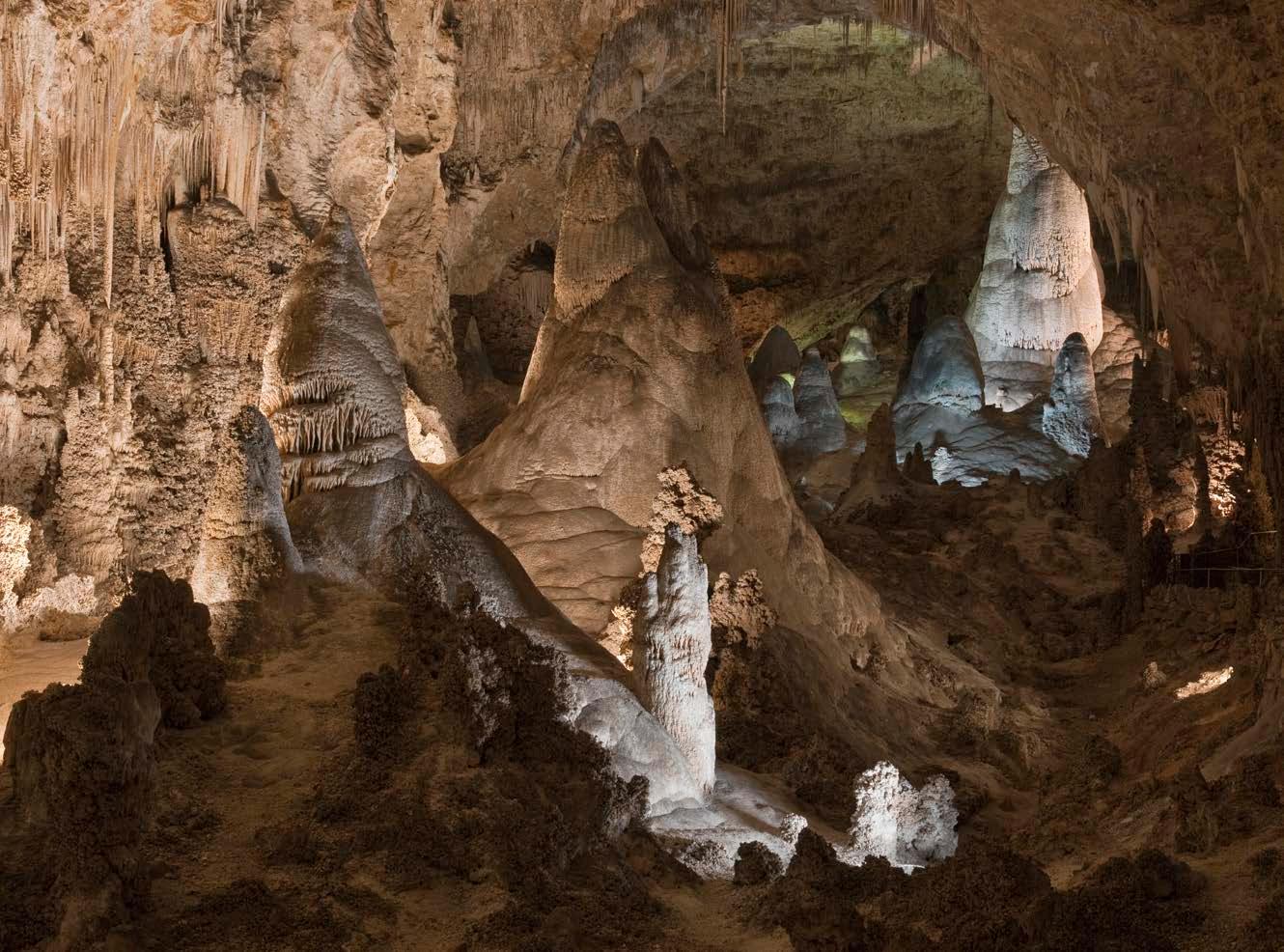
3 minute read
Carlsbad Caverns National Park
Situated near the New Mexico-Texas border and featuring 30 miles of passages — including the country’s largest subterranean chamber — Carlsbad Caverns National Park stacks up to the splendor of any of the world’s most touted wonders. A labyrinth of more than 119 caves was formed when sulfuric acid dissolved limestone, resulting in caverns of all shapes and sizes that beg to be explored.
The above-ground Chihuahuan Desert is no less intriguing with its sea ledges, plummeting canyons, flowering, drought-tolerant flora and desert-adapted wildlife that thrives despite stark conditions. About 2/3 of the park consists of wilderness.
Human activities — including prehistoric and historic Native American occupations, European exploration and settlement, and industrial exploitation — have shaped the park’s rich, diverse history.
There are two historic districts on the National Register of Historic Places — Rattlesnake Springs Historic District, an oasis with permanently flowing water, homesteaded and farmed in 1880 by former U.S. President William Henry Harrison, and the Cavern Historic District, a complex built between the early 1920s and 1942. Originally done in the Pueblo Revival style and later in the New Mexico Territorial Revival style, it’s located near the entrance of Carlsbad
Caverns. There is also a museum that preserves and protects about one million cultural artifacts.
The Flora And Fauna
Not lacking for wildlife or plant life, Carlsbad has identified 67 species of mammals, among them 17 species of bats, in addition to 357 species of birds and 55 different reptile and amphibian species. A year-round habitat for cougars, it’s also a nesting habitat for migratory species, the most notable of which are vast colonies of cave swallows.
Daily around nightfall, half a million Mexican free-tail bats swarm from the Carlsbad Caverns entrance to feed. Check with a park ranger for the most up-to-date information on bat flight programs.
Located at the intersection of the northern Chihuahuan Desert, southern Rocky Mountains and southwestern Great Plains, the park is more than half-covered in desert shrubland, while the remainder consists of grassland, arroyo riparian woodland and shrubland, a smattering of herbaceous wetlands, and forested wetland at Rattlesnake Spring. There are various cliff, barren, rock and arroyo plant communities, too.
The Weather
Given its location in the Chihuahuan Desert in southeastern New Mexico, summer temperatures usually range from 90 F to the low 100s F. And there is an average of 278 days of sunshine. Although it’s windy and mild in spring, late summer and fall see frequent rain and winter may mean icy conditions and occasional snow. Watch weather forecasts and conditions on the park’s website.
THE HIKES, DRIVES AND VIEWPOINTS
Note that the park offers (when available) several ranger-led tours through its focal cave, varying in difficulty, duration and age limit. Children under the age of four are not allowed on any of the ranger-led tours.

Dunes Drive
Sledding down the slip face of dunes is a popular, thrilling activity that’s allowed in the loop portion of Dunes Drive, where there is little or no vegetation. Most sledders use waxed plastic snow-saucers. Didn’t bring one? No worries — they can be purchased at the park gift shop.
Natural Entrance Trail
A steep 1.25-mile trail — complete with curving switchbacks, the Natural Entrance Trail descends 75 stories into Carlsbad’s network of 119 limestone caves. (There is also an elevator you can take to enter, and tickets are required.) From formations like Devil’s Spring to the Whale’s Mouth and 200,000-ton behemoth Iceberg Rock, its scale and grandeur will leave you speechless.
Big Room Trail
Taking you to view the largest single cave chamber by volume in North America, the .6-mile Big Room Trail was described by actor-comedian Will Rogers as the “Grand Canyon with a roof over it.” Marvel at cave formations of all shapes and sizes; witness the world’s largest stalagmite; and see the rope ladder used by explorers in 1924.
Slaughter Canyon Cave Trail
Narrow, uneven and quite slippery, the Slaughter Canyon Cave Trail is a wild cave tour with only your headlight to guide you. Among the sights is 89-foot-high Monarch, one of the world’s tallest columns; the delicate Chinese Wall, an ankle-high rimstone dam; and the glittering Christmas Tree, a crystal-adorned column.
Walnut Canyon Desert Drive
A picturesque, 9.5-mile gravel road that loops through Carlsbad Caverns National Park, Walnut Canyon Desert
Drive affords views of the spectacular desert landscape. At the oasis of Rattlesnake Springs, pause to observe the fascinating desert wetland, which attracts reptiles. Note that low clearance vehicles, RVs and trailers are not permitted.
Rattlesnake Canyon Trailhead
The Rattlesnake Canyon Upper Loop Trail is a 6-mile hike from the Rattlesnake Canyon Trailhead to the Guadalupe Ridge, taking you down to the Walnut Canyon Desert Drive before ascending back up to where the trail began.
About The Park
Location
Chihuahuan Desert, in southeastern New Mexico
ESTABLISHED
May 14, 1930
AREA
46,766 acres










